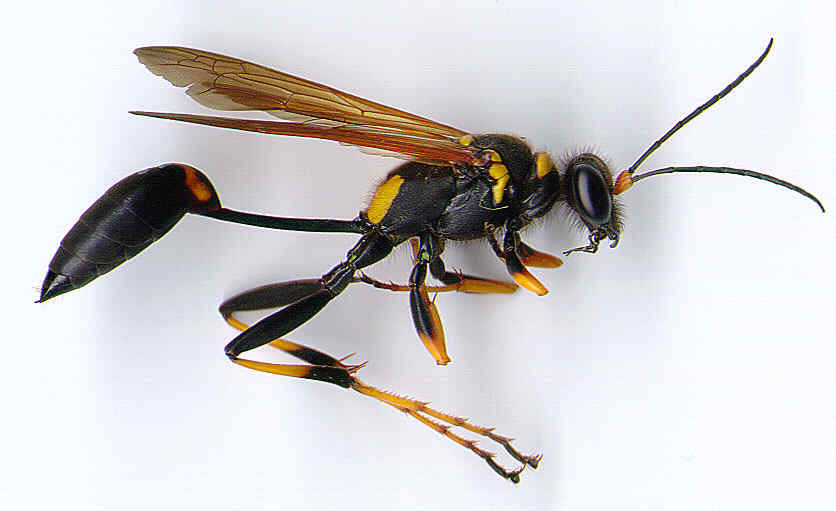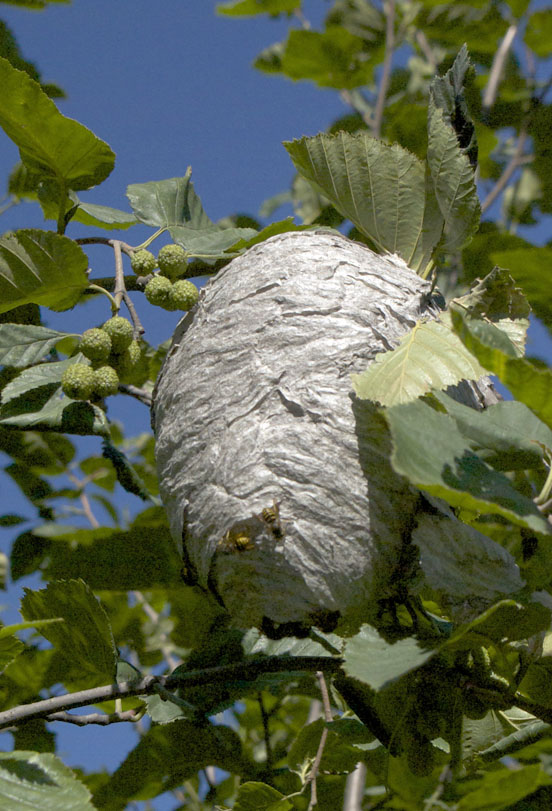



Wasp
ONE NEST MORE.
EDWARD CARSON is an intelligent lad, something over ten years old, who takes great interest in all that is going on around him.
Like most other boys, he loves play, and, like some other boys, he loves work. He also loves his parents and friends, loves his Sabbath-school and the week school, and is making good progress in his studies.
We call him a pretty good boy; but he has some faults we would like to have him correct.
It is vacation now, and according to promise, he is visiting his uncle, aunt, and cousins, and having a fine time. The cows to bring up and milk, horses to get and harness, fruit and eggs to gather, he finds plenty to occupy the time from morning to night. Sometimes a bumblebee's nest is found, from which, with great care, and fear of being stung, a little honey is obtained, and called a prize.
One day he came to the house in great excitement, one side of his face much swollen and red.
"What is the matter now, my boy, another bee's nest today?"
"No, uncle, not a bee's nest, but a nest with plenty of sting in it, but no honey."
"Ah! The hornets have been at you, have they?" said his uncle.
"Were they hornets, uncle? The boys called them 'yellow-jackets;' and they came out of a little gray nest on a bush, about as large as my head, which I only just touched accidentally as I passed by."
"Yes; they are sometimes called by that name, because they have yellow bodies with brown stripes across them. Their nests, or homes, are very curiously arranged, all made of a very soft, thin paper, which the little fellows spread out in sheets formed from decaying wood.
"The nest is usually shaped like a strawberry or pineapple, the smaller end down, with a very small opening at the bottom. This serves to keep out all the rain, and, with only one small door, they are able to keep out all enemies.
"Perhaps the next nest you find will be on the ground by the side of a stone, or sod of grass; but the door, or place where they come out and go in, will always be at or near the bottom.
"They have a large family of cousins, called 'wasps,' which are also easily irritated, and sure to sting at the first opportunity; and this is why we say of some boys and girls who are always fretful, 'They are waspish.'"
"But, uncle, I don't want to be stung any more, and I would like to know how to destroy that nest, and every one I find; and I'll watch for them all the time."
"Well, the way I do when I discover a nest of these naughty chaps where I think nobody will be likely to be harmed by them, is to let them entirely alone; but if it is a frequented place, where children or others often pass, I wait until evening, when they are all within, and then apply a burning torch, or if the nest is on the ground, stamp it all to pieces, with my foot."
"I am afraid of them, it hurt so when I was stung; but if cousin Ben will help me, I'll try it anyhow."
Within the next three weeks the two boys had destroyed that nest and two others; but the fourth one, which was situated between two pieces of wood, seemed for a long time to defy them both.
They had been stung several times, and had always to retreat. This, together with several other little mishaps, had often sadly irritated Edward, and caused a certain little organ to be very unruly, and send out some unpleasant sounds.
One day soon after, he came up to his uncle in quite a hurry, and said,
"We have ruined that nest, and that is the last one I know of."
"Isn't there one more?" said uncle slowly.
"Not that I know of. That is the last one; and I am glad of it."
"One nest more," said uncle, "that I want my little boy to destroy; for if he does not destroy it, he will be stung by it as long as he lives."
"What is it?" asked the little fellow with eagerness.
"The nest of waspish thoughts and feelings, which so often cause fretty, scolding words to fly out of your mouth, and sting our ears."
"I will try, uncle. But 'tis so hard, for I speak before I think, and then I know it's naughty."
Remember that sweet promise, "Him that overcometh will I grant to sit with me in my throne."
Well-Spring.
THE WASP.
I DARE say you think that the wasp is an ugly, bad-tempered insect, who does nothing in the world but sting little children. She is apt to do this when she is meddled with. Of all things, she dislikes a meddler. Yet, when she seems to be buzzing about, seeking whom she may sting, she is really busy making a home for her young.
I watched her at work the other day. She had chosen the ceiling of my room, where the open window allowed her to pass in and out. She had already made a little clay hut with an opening at one end. In order to set her mind at rest, I let her finish her cradle and nursery. Daily it grew bigger, till it was perhaps as large as a large plum.
Then one day she closed and locked the door, so to speak, and flew away.
When her back was turned, I broke into her mud cabin like a burglar. I found there two tiny rolls of something that looked like cotton-wool. Each was wrapped in a brown, gauzy blanket, and they were, in reality, the wasp's babies,—their larvae.
The wasp is a worm before she gets her wings and sting. All around were lying the bodies of dead flies and spiders, which the wise mother-wasp had stung with her sting, and sealed up with her babies in their snug quarters. When they woke up hungry, they would find plenty of food in the cupboard.
This little worker was one of the wasps that live alone; but there are others who live together in little tenement houses of their own. They not only build their houses themselves, but they make the pasteboard for the walls and chambers from shreds of wood, as we make rags into paper.
—Our Little Ones



A WASP'S NEST.
You have seen and admired it many a time, no doubt, but perhaps you have never seen the kind of which I am going to tell you. A dark brown wasp, with yellow bands across his jacket, and bright yellow feet, builds a round nest of yellow clay, which is a very peculiar kind of structure.
The grown-up wasp takes some wet clay and works it into a round pellet. Then with head and forefeet it presses it down to the surface on which it is building.
The inside of the round ball is smooth, and when the work is considered good enough, the wasp goes off and catches a small spider. This it stings in just such a way as to paralyze without killing it, and then it is dropped into the little house.
An egg is then laid beside the spider, and the wasp goes on catching spiders, until twelve or fifteen are snugly tucked away. Then a clay cover is made for the opening, and another room is built in the same way. What are the spiders for, do you say? For the new wasp to feed upon.
The old wasp knows just how many it will take for the young larva until it is old enough to become a pupa. When the spiders are all eaten, the young wasp gnaws a round hole in the wall of its cell, and comes out to enter upon the active duties of a wasp's life.
S. S. Advocate